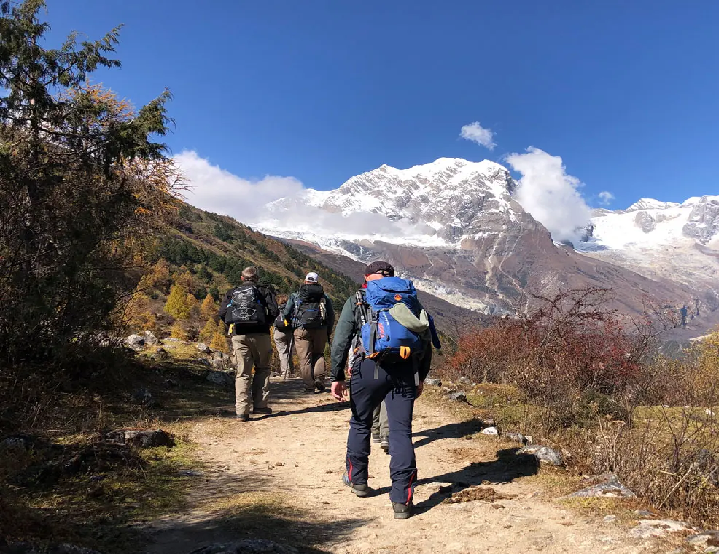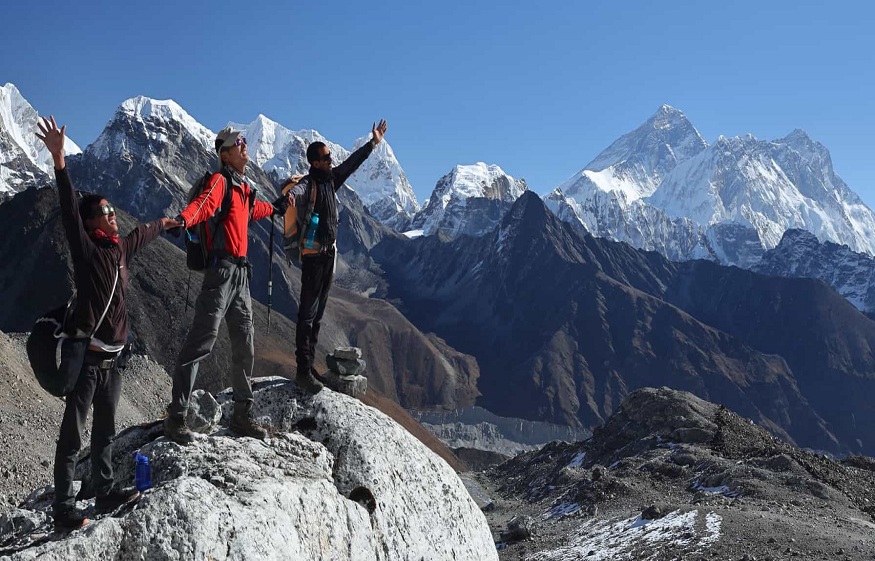In the heart of the Nepalese Himalayas, where antiquated ice sheets whisper stories of continuance and peaks puncture the sky, lies a travel that characterizes both physical diligence and otherworldly arousal—The Icebound trek. This awe-inspiring experience mixes three of the region’s most famous encounters: the Everest Base Camp trek, the Island peak Climbing endeavor, and the emotional crossing of the Cho La Pass. This is not a fair trek, but a multi-faceted trek over snowfields, tall passes, and solidified dreams—a trek through the exceptional soul of the Himalayas.
Everest Base Camp trek The Strides of Legends
The trip starts on the revered way to Everest Base Camp( EBC), a path sculpted by legends and visionaries. The trip begins with an instigative flight from Kathmandu to Lukla — the little mountain heliport roosted on an edge, setting the tone for what’s to come. From there, pedestrians rise sluggishly through Sherpa municipalities, rich forestlands of pine and rhododendron, and thundering aqueducts nourished by the Khumbu Glacier.
Every step toward Everest Base Camp is an exchange with history.As trekkers pass through Namche Bazaar, the dynamic Sherpa capital, and Tengboche, home to the most elevated Buddhist religious community in the locale, they experience a richly embroidered artwork of culture woven with otherworldly existence, strength, and warmth.
The scene morphs significantly—from greenery to desolate, wind-swept good countries—some time recently coming full circle at the stark, glacier-covered fields of Everest Base Camp (5,364 meters). Here, at the base of the world’s most elevated mountain, climbers accumulate in their tents amid undertaking seasons, planning for the extreme summit. For trekkers, it’s a dreamlike and enthusiastic high point—standing in the shadows of giants.
But the Icebound trek doesn’t halt here; it, as it were, deepens.
Cho La Pass trek: Through the Solidified Gates
Departing from Everest Base Camp, the trip takes an instigative bend with the rising of the Cho La Pass trek ( 5,420 measures) — a high- altitude section that challenges the body and rewards the soul.The path weaves through Lobuche and Dzongla, displaying sensational views checked by frigid lakes, cascading icefalls, and spiked ridgelines.
Crossing Cho La is both an elevated and a mental test. The way climbs steeply over free shake, frigid edges, and frosty moraines. It requests beyond any doubt balance and immovable resolve. At the beat of the pass, a clearing display unfurls—the sky tinged with sapphire blues and the snow-capped peaks of Ama Dablam, Cholatse, and the ever-present Everest standing in noiseless watch.
Cho La is the turning point—the entryway between EBC and the last chapter of the trek: the Island peak climb. Slipping into the Gokyo Valley, trekkers are frequently welcomed with emerald lakes shining like mirrors beneath the solidified sun—a dreamlike contrast to the glaciered statues above
Island peak Climbing: The Last Ascent
Rising strongly at 6,189 meters, Island peak climbing (Imja Tse) is the crown jewel of this Himalayan set of three. In spite of the fact that it is actually a trekking peak, Island peak requests climbing equipment, ice sheet travel, and summit abilities—a genuine snow-capped involvement that tests everything the body and intellect have learned so far.
The approach to base camp takes travelers through Chhukung Valley, a wide, desolate scope flanked by mammoth ice dividers and perfect edges. Island peak looks misleadingly tame from a far distance, but as climbers approach its base, the full scale of the challenge becomes clear. Restricted segments, uncovered ice, and soaked headwalls characterize the summit route.
Climbers start their last rising some time recently at daybreak, headlamps cutting through the haziness, crampons crunching on solidified territory. The course climbs over the Imja Icy Mass, arranging chasms and steps, and some time recently came to the notorious 45-50° ice slant close to the summit. The last thrust, regularly done with settled ropes, is a vertical fight with gravity and self-doubt.
Reaching the summit of Island peak is nothing short of euphoric. The 360-degree view reveals the peaks of Lhotse, Nuptse, Baruntse, and the far-off outline of Makalu. Here, the Icebound trek finds its climax—not fair in elevation, but in accomplishment. It is the minute where battle meets tranquility, and fear turns into fulfillment.
Culture and Companionship: The Soul of the trek
Beyond the trails and summits, it’s the human association that characterizes this travel. Along the course, trekkers and climbers shape a close-knit bond with individual travelers and local people alike. Warm tea houses run by Sherpa families give protection and stories. Mani dividers, supplication banners, and turning wheels remind globe-trotters that the mountains are sacrosanct, and each step is an otherworldly one.
The Sherpa guides, with their unmatched quality and lowliness, are the calm heroes of this trek. Their information about the landscape and profound association with the area raise the travel from a simple experience to social immersion
Challenges of the Icebound Path
The Icebound trek is not for the faint of heart. Altitude sickness, solidifying temperatures, eccentric climate, and the physical cost of ceaseless trekking and climbing make it one of the most requested Himalayan experiences. Arrangement, acclimatization, and appropriate direction are essential.
Yet it is these exceptional hardships that deliver the travel its soul. It is in the hurting muscles, the breathless risings, and the solidified mornings that one finds their most genuine self. The Himalayas don’t give fair tests—they teach.
Conclusion: A Travel Past Peaks
The Icebound trek is more than a trek. It’s a meeting of scenes, legends, and life-changing minutes. From the legendary trails of Everest Base Camp, over the frigid dramatization of Cho La Pass, to the brave statues of Island peak, this travel is an orchestra of continuance, wonder, and self-discovery.
For those who set out to reply to the Himalayas’ frigid call, this set of three conveys an encounter that waits long after the snow has liquefied from their boots. It’s an update that in the coldest, most elevated corners of the world, one can discover the hottest truths of the human spirit.
Tips for the trek:
Best Season: Pre-monsoon (March to May) and post-monsoon (October to early December).
Required Grants: TIMS card, Sagarmatha National Speak permit, Island peak climbing permit.
Training Required: High-altitude trekking experience, fundamental climbing information (for Island peak), and great physical conditioning.




